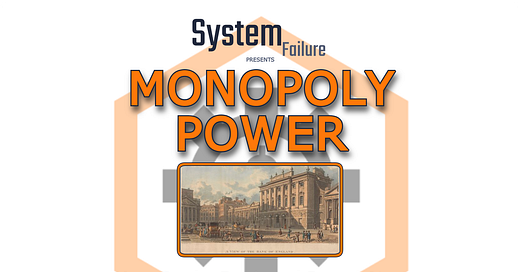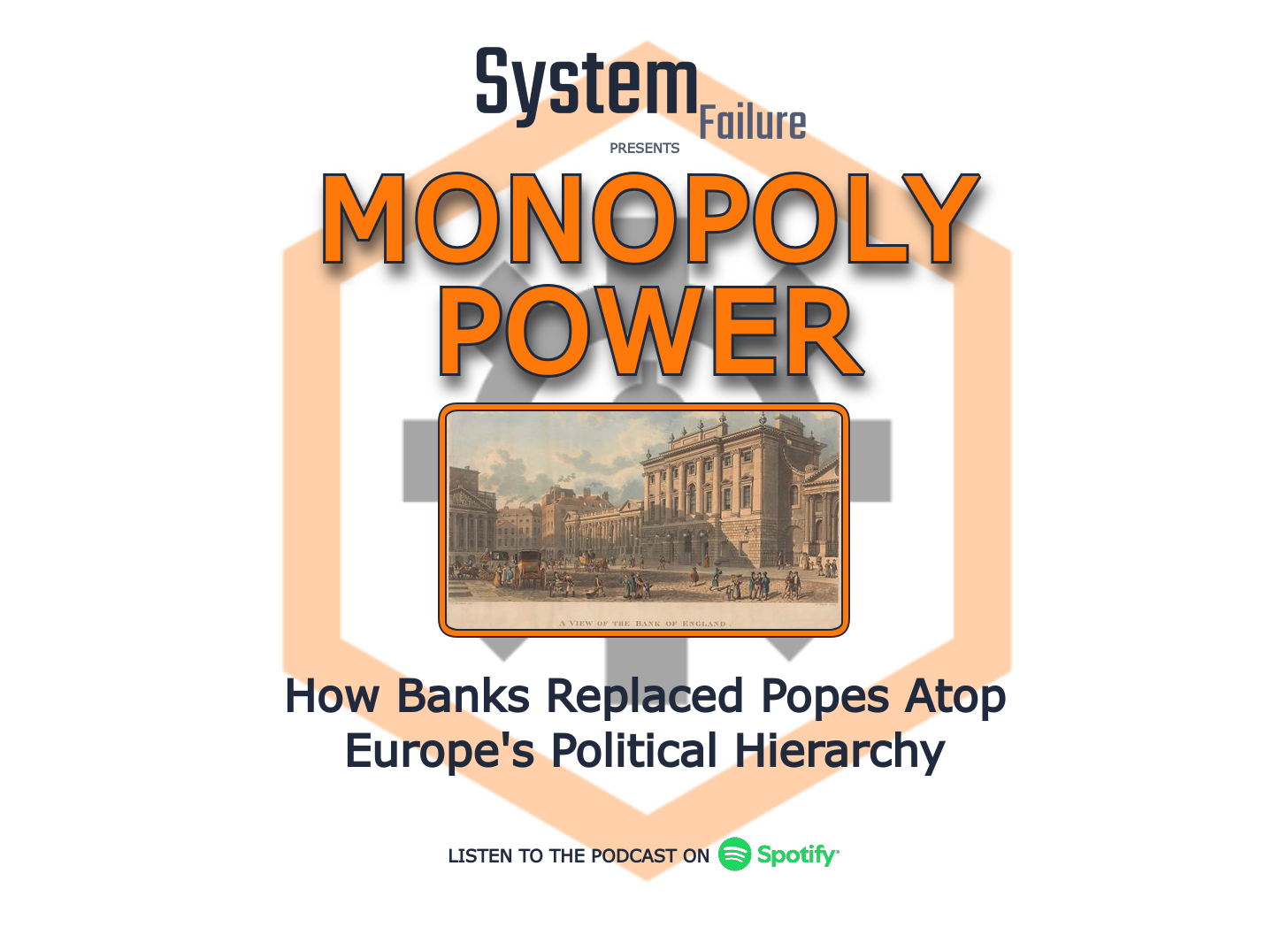Overview
The following essay briefly describes how we came to be ruled by banks. Central banks took over for the Popes after the power and influence of the Papacy was limited by the Protestant Reformation. The timing is revealing; the ink had barely dried on the Treaty of Westphalia in 1648 when the first central bank popped up in England in 1694.
The Popes amassed a historic fortune by monetizing a perceived monopoly on access to God; they shamelessly charged people for God’s forgiveness of their sins. This so-called Sale of Indulgences was a major factor in the Protestant Reformation.
Today, central banks profit from an analogous monopoly, this one on currency issuance. Their monopoly is every bit as faith-based as the belief that the Vatican possessed some inside connection with God.
Banks are not what they appear to be. Their cover story is that they keep deposits safe and profit by loaning those deposits out. But that’s a transparent lie. You can tell because the bank never draws down your checking account balance when it loans out your money.
In reality, banks are in the business of creating and destroying currency. When they approve you for a loan, banks aren’t actually handing out their depositors’ money. They’re actually just crediting your account with currency created out of thin air.
Almost all currency comes into existence through lending; only around 3% of our money supply was ever minted by some central authority. 97% of it is conjured into existence. The whole enterprise is a lot more faith-based than our authorities would like us to know.
The alchemy that creates most of our currency is called Fractional-Reserve Banking. It’s been roundly criticized as counterfeiting, but fractional-reserve lending and central banks are interconnected components of the modern banking and monetary system. In the United States, even our one publicly-owned bank—the Bank of North Dakota—is bound by reserve requirements set by our Federal Reserve. The central banking system possesses a total monopoly on currency insurance…
Introduction
The Reformation removed the Popes from the top spot in the European political hierarchy, but that power vacuum was filled a few short decades later by banking houses. These banks inherited a position of political dominance once occupied by Caesars, who bequeathed it to the Popes after the Fall of Rome. Like the Popes, the bankers bolstered their wealth and power with a perceived monopoly. But instead of a monopoly on access to God, they established a monopoly on access to currency.
Banking
The Medici of Florence challenged the Vatican by commissioning pagan artwork and taking a keen interest in magic. Their successors, the Fuggers of Germany, sought to multiply their fortune by loaning out money at interest. In those days the Roman Catholic Church staunchly forbade moneylending, while the Protestants were much more lenient. Therefore, even though they were devout Catholics, the Fuggers financially supported Protestant factions within the Holy Roman Empire.
In these ways, the Medici and the Fuggers challenged the power of the Vatican. But neither banking house actually seized that power for themselves. That feat was accomplished by the Bank of England.
The Popes dominated European politics during the Middle Ages. But the sun finally set on their political dominance after the signing of the Treaty of Westphalia in 1648. The gaping void at the apex of European politics lasted only 46 years before it was filled by banking houses similar to the Medicis and the Fuggers; in 1694 the Bank of England was founded and the world’s very first Central Bank was born.
Bank of England
As the 1600s drew to a close, King William III of England ran short on funds for his ongoing war with France. A group of wealthy bankers stepped up to loan him the money he needed. There was one condition: they demanded the exclusive right to print and sell pieces of paper entitling the bearer to some of the King’s future tax receipts.
The resulting paper notes had real value because they were exchangeable for the King’s money on a particular future date. These notes were just the King’s IOUs. But they were backed by government authority and perceived as reliable, so they were widely adopted as the world’s very first paper currency. Its monopoly on printing these IOUs made the Bank of England the world’s very first central bank.
Monopoly
The Popes monetized the belief that they were the sole Vicars of Christ on Earth by setting up a toll booth on access to heaven. The so-called Sale of Indulgences was a major cause of the Protestant Reformation that cost the Popes their position of political dominance.
Central bankers followed in their footsteps by establishing a monopoly on currency issuance itself. They monetize this monopoly by charging the rest of us for access to currency—otherwise called interest on a loan.
Fractional-Reserve Banking
During the Middle Ages, people rarely questioned the Church’s representation of reality. To them, the Vatican’s teachings were bedrock reality. It wasn’t until the Black Death exposed Church incompetence that people started having their doubts.
Similarly, we don’t spend much time thinking about our banking system. We uncritically deposit our money in banks and pay interest on our various loans because it seems necessary.
We don’t think about how banks loan out our money without reducing our account balances to reflect it. Your debit card always approves transactions for your full checking account balance, even though that money’s often loaned out. This innovation is called Fractional-Reserve Banking, and it allows banks to create currency when they make a loan, instead of drawing down depositors’ account balances. In other words, banks conjure up money out of thin air and charge interest to access it. Some believe fractional-reserve lending amounts to counterfeiting. The whole system relies more on faith than our authorities would like us to know.
Conclusion
In the year 800, Pope Leo III elevated himself politically over Charlemagne by placing the crown of the Holy Roman Empire on his head. The Popes went on to enjoy political dominance over the crowned heads of Christendom for almost 900 years, until the Protestant Reformation curtailed their power. In 1694, international bankers stepped into the power vacuum left by the Popes. Like Leo, they elevated themselves over the monarchs of Europe, this time by loaning them money. And they still hold that position of political dominance today.
Further Reading
It was only with the creation of the Bank of England in 1694 that one can speak of genuine paper money, since its banknotes were in no sense bonds. They were rooted, like all the others, in the king’s war debts. This can’t be emphasized enough. The fact that money was no longer a debt owed to the king, but a debt owed by the king, made it very different than what it had been before. In many ways, it had become a mirror image of older forms of money. The reader will recall that the Bank of England was created when a consortium of forty London and Edinburgh merchants—mostly already creditors to the crown—offered King William III a £1.2 million loan to help finance his war against France. In doing so, they also convinced him to allow them in return to form a corporation with a monopoly on the issuance of banknotes—which were, in effect, promissory notes for the money the king now owed them. This was the first independent national central bank, and it became the clearinghouse for debts owed between smaller banks; the notes soon developed into the first European national paper currency.
David Graeber, Debt: The First 5000 Years, 2011, page 339
Contrary to popular belief, the U.S. government can’t “just print money,” because American money is not issued by the Federal government at all, but by private banks, under the aegis of the Federal Reserve System. The Federal Reserve, in turn, is a peculiar sort of public-private hybrid, a consortium of privately owned banks whose Governing Board is appointed by the U.S. president, with Congressional approval, but which otherwise operates autonomously. All dollar bills in circulation in America are “Federal Reserve Notes”—the Fed issues them as promissory notes and commissions the U.S. mint to do the actual printing, paying it four cents for each bill. The arrangement is just a variation of the scheme originally pioneered by the Bank of England, whereby the Fed “loans” money to the United States government by purchasing treasury bonds, and then monetizes the U.S. debt by lending the money thus owed by the government to other banks. The difference is that while the Bank of England originally loaned the king gold, the Fed simply whisks the money into existence by saying that it’s there. Thus, it’s the Fed that has the power to print money. The banks that receive loans from the Fed are no longer permitted to print money themselves, but they are allowed to create virtual money by making loans ostensibly, at a fractional reserve rate established by the Fed—though in practice, even these restrictions have become largely theoretical.
David Graeber, Debt: The First 5000 Years, 2011, page 365






The last paragraph from David Graeber is something that’s gonna take me a lot of time to digest. The twist and turns to allow for money to be printed out of thin air is absolutely scary. If my memory serves me well, money is not even backed up by Gold anymore since the Nixon administration. Maybe I’m wrong (because economics is not my expertise) but I think the validity of the dollar, relies solely on the influence the United States has politically and militarily in relationship to the world. Also, I think cryptos like Bitcoin and Etheruem present a threat to U.S. currency and perhaps that’s why they’re trying to put a ton of regulations on it. What’s your take on this, Nathan?
I learned so much from your substack! You rock!